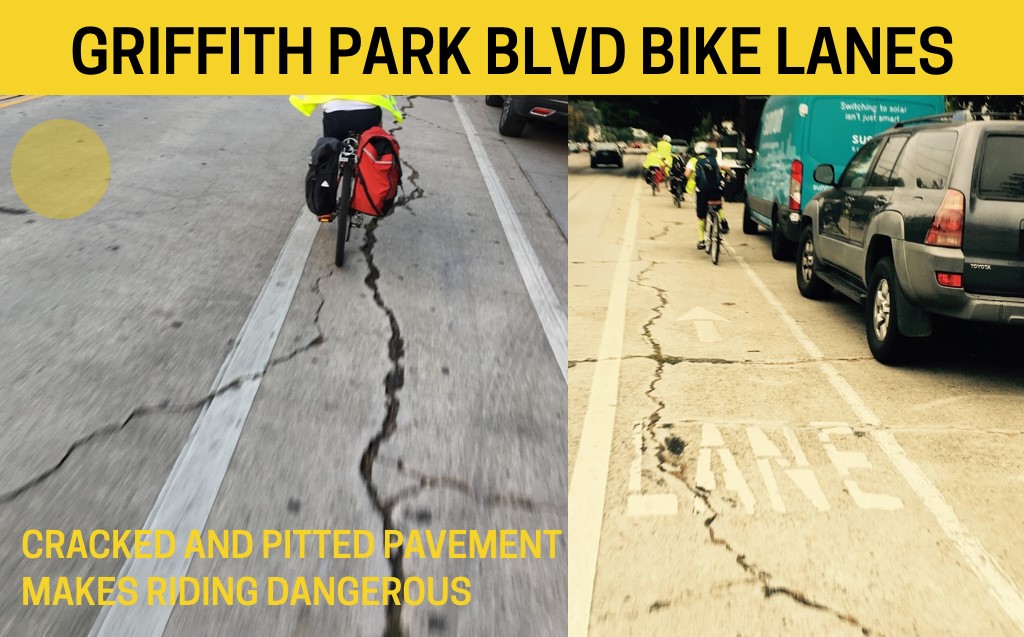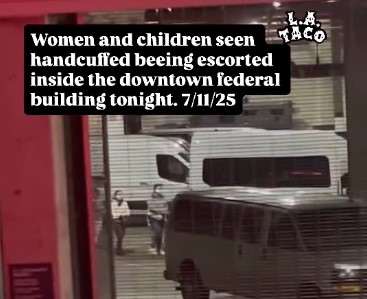Note: Metropolitan Shuttle, a leader in bus shuttle rentals, regularly sponsors coverage on Streetsblog San Francisco and Streetsblog Los Angeles. Unless noted in the story, Metropolitan Shuttle is not consulted for the content or editorial direction of the sponsored content.
At a recent Los Angeles City Bicycle Advisory Committee (BAC) subcommittee meeting, Transportation Department (LADOT) Senior Transportation Engineer Pauline Chan reported that the City Attorney had recommended removing the bike lanes from Griffith Park Boulevard. The reason Chan gave is that there were at least two lawsuits due to bike crashes that took place there. According to meeting minutes, LADOT staff reported that "this won't be the last removal [because] there is now a higher expectation of street condition for roads with bike lanes."
Removing the bike lanes would not make Griffith Park Blvd safer. It's not clear that it would insulate the city from liability.
The Griffith Park Boulevard bike lanes run 1.6 miles from Lucille Avenue (near the Sunset Triangle Plaza) nearly to Los Feliz Boulevard, in the communities of Silver Lake and Los Feliz. Even before the bike lanes were added, Griffith Park Blvd offered a safe, convenient, quiet, and relatively flat alternative to the excessively fast parallel stroad Hyperion Avenue.
The Griffith Park Blvd bike lanes were implemented in 2001 after a campaign push from the L.A. County Bicycle Coalition. Neighbors supported the bike lanes and stop signs to curb speeding motorists.
Griffith Park Boulevard is one of L.A.'s aging concrete streets. Roughly 5 percent of L.A. streets are concrete; most are asphalt. The concrete streets were built in central Los Angeles, mostly circa the 1930s-1940s, so they are now showing their age. City Councilmember David Ryu has pushed for the city to repair its aging concrete streets, including shepherding a motion (council file 16-0395-S1) directing various city departments to analyze concrete repair pilots and report back with a plan to address the backlog of concrete street repairs. The plan appears to be more than six months overdue. In July, the city approved a one-time $1 million allocation in the Fiscal Year 2018-19 budget (page 893) for the Bureau of Street Services for "the reconstruction of concrete streets across the City" though it is not clear where this funding will be used. It is clear that it will just be a downpayment on hundreds, probably thousands, of miles of concrete street repairs needed.
Earlier this month, the full city BAC came out against the removal of the Griffith Park Blvd lanes, unanimously approving a motion to instead repair the street:
BAC recommends that, in light of FY 2018-19 funding allocated to Bureau of Street Services for concrete road repair that this be utilized for repairing Griffith Park Blvd. bike lanes as deemed necessary, and we further request that Bureau of Street Services be involved in any future public hearings regarding this matter.
The City Attorney's office did not respond to email inquiries for details, but last week LADOT spokesperson Oliver Hou confirmed that:
We [LADOT] are working with BSS [Bureau of Street Services] to prioritize bike network streets in need of repair, and will report back to Council with recommendations. These recommendations will include a capital plan for repairing pavement conditions in bike lanes citywide. We expect the analysis to take 2 to 3 months.
In the meantime, we are working with BSS to evaluate options for temporary repair of the bike lane surface on Griffith Park Bl. There are no immediate plans to remove bike lanes from Griffith Park Bl or other streets in need of repair.
Hou confirmed that City Attorney recommendation for removing Griffith Park Blvd bike lanes was due to these two solo bicyclist crash cases:
The crash in the Pascal case actually took place at a location where Griffith Park Boulevard has no bike lanes - north of Los Feliz Boulevard. In early 2018, city crews repaired the concrete in the area where Pascal crashed.
The O'Hare crash did take place in a Griffith Park Boulevard bike lane.
So, there were two Griffith Park Boulevard crashes. One crash in bike lane. One not. This seems to indicate that the problem is not the actual presence of bike lanes.
The City Attorney's recommendation seems to be - like inaccurate recent media accounts, councilmember statements, and a recent motion by councilmember Mitch Englander - based on the misconception that L.A. bicycling takes place in bike lanes. As people who bike understand, L.A.'s bikeway network is inadequate, so most bicycling takes place on streets that lack bicycle facilities. Bicycling takes place all over Los Angeles. Bike lanes do not somehow draw cyclists, they acknowledge that bicyclists are already using L.A. streets, and that the city has a responsibility to keep them safe.
To reiterate points from this earlier SBLA article (data from calendar year 2017):
- Bike lanes are not the problem. L.A. city settled five solo bike crash lawsuits; only one of the five took place in a bike lane.
- Car lawsuit settlements cost the city more than double that from bikes. L.A. paid $18.9 million for bike lawsuits, while car crash lawsuits (cars vs. bike/ped/car/etc.) cost the city $40.9 million.
There is a pernicious double standard here. Neither the media, nor the council, nor the City Attorney, have called for removing car lanes due to city lawsuit payouts. A few courageous councilmembers and LADOT Vision Zero staff have been supportive of making streets safer, which, in addition to saving lives, reduces city liability costs. But in large part the city council has gotten in the way of efforts to make L.A. streets less deadly.
Would removing the bike lane make anyone safer? No. It does nothing to fix the underlying safety issues with the cracked concrete street.
Would it actually reduce city liability? It appears that liability lawyers are able to win cases against the city, whether cyclists are in bike lanes or not (and, as stated above, most often these bicyclist lawsuits take place on streets with no bike lanes.) But perhaps it's a little worse for the city to fight cases where crashes took place in bike facilities. But would the city's case be stronger on a street which had safety features, but where the city had removed those safety features? Studies show that bike lanes help cyclists and drivers position themselves more safely. If bike lanes are removed from a street, and a cyclist is hit by a driver, then the cyclist may be able to assert that the city is liable for removing a safety feature that might have prevented the crash. Studies also find that bike facilities make streets safer for all road users, so a pedestrian or driver might make a similar case.
Better to fix the underlying problem than to remove the bike lane that has little to do with it.
Fix the street.
(To get caught up fixing streets, the city could stop widening streets, so it doesn't dig itself a deeper street repair deficit - recently estimated at $3-4 billion.)
Griffith Park Boulevard is a flat quiet street that cyclists utilized before it had bike lanes. Removing its bike lanes would not remove the cyclists.
Removing these lanes would set a dangerous precedent, and making more of L.A.'s streets more deadly, which would be worse for city liability.







